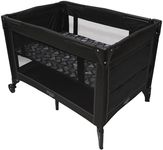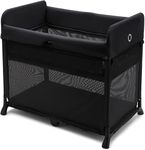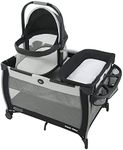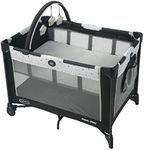Buying Guide for the Best Travel Cribs
Choosing a travel crib can make a big difference in your travel experience with a baby or toddler. The right travel crib should be safe, comfortable, easy to set up, and convenient to carry. Before you start shopping, think about how often you'll use it, where you'll be traveling, and how much space you have for packing. Understanding the key features will help you find a travel crib that fits your family's needs and makes your trips smoother.Weight and PortabilityWeight and portability refer to how heavy the travel crib is and how easy it is to carry or transport. This is important because you'll likely be moving the crib between locations, possibly through airports or in and out of cars. Travel cribs can range from very lightweight models that are easy to carry with one hand, to heavier ones that may be more cumbersome. If you travel frequently or need to carry the crib long distances, a lighter, more compact model is ideal. If you only need to move it occasionally or have plenty of space, a heavier crib with more features might work for you.
Ease of Setup and Take DownThis spec describes how quickly and simply you can assemble and disassemble the travel crib. Some cribs pop open in seconds, while others require more steps and time. If you expect to set up the crib often or in a hurry (like after a long trip), look for a model with a straightforward, tool-free setup. If you don’t mind spending a few extra minutes, a more complex crib might be acceptable, especially if it offers other benefits.
Size and Sleeping SpaceSize and sleeping space refer to the dimensions of the crib when set up and how much room your child will have to sleep and move. This is important for your child’s comfort and for fitting the crib into different spaces, like hotel rooms or small apartments. Travel cribs come in various sizes, from compact models for infants to larger ones that can accommodate toddlers. If your child is older or you want the crib to last longer, choose a larger model. For newborns or if space is tight, a smaller crib may be better.
Mattress Comfort and SupportThe mattress is where your child will sleep, so its comfort and support are crucial for good rest and safety. Some travel cribs have thin, firm mattresses, while others offer more padding. A firmer mattress is generally safer for infants, while older babies and toddlers may appreciate a bit more cushioning. Consider your child’s age and sleep preferences when choosing the right mattress type.
Safety FeaturesSafety features include things like sturdy construction, breathable mesh sides, secure locking mechanisms, and compliance with safety standards. These features are important to prevent accidents and ensure your child’s well-being. Look for cribs with mesh sides for airflow and visibility, and check that all parts lock securely in place. If you plan to use the crib for naps and overnight sleep, make sure it meets recognized safety certifications.
Age and Weight LimitsAge and weight limits tell you the recommended range for safe use of the crib. This is important to ensure your child fits comfortably and safely. Travel cribs are usually designed for infants up to toddlers, but the exact limits vary. If you want the crib to last through multiple stages, pick one with higher age and weight limits. For short-term use or younger babies, a crib with lower limits may be sufficient.
Additional FeaturesSome travel cribs come with extra features like carrying bags, changing stations, or the ability to convert into playpens. These can add convenience but may also increase weight or complexity. Think about which extras would actually be useful for your travel style. If you value simplicity, stick to basic models; if you want more versatility, look for cribs with added functions.












